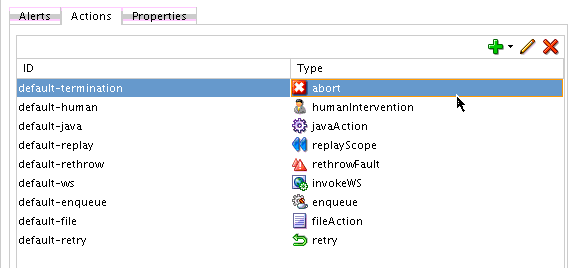- Developing SOA Applications with Oracle SOA Suite
- Using the BPEL Process Service Component
- Using Fault Handling in a BPEL Process
- Handling Faults with the Fault Management Framework
- How to Design a Fault Policy for Automated Fault Recovery with the Fault Policy Wizard
- Step 3: Defining Actions
Step 3: Defining Actions
- Click the Actions tab. By default, all types of actions are automatically selected. Figure 12-15 provides details.
Figure 12-15 Actions Section of Fault Policy Editor

Description of "Figure 12-15 Actions Section of Fault Policy Editor"Table 12-3 describes the available action types.
Table 12-3 Supported Action Types
Action Description Abort
Terminates the entire business flow.
Human intervention
Causes the current activity to stop processing. Human intervention from Oracle Enterprise Manager Fusion Middleware Control is required to handle the fault. For information, see "Recovering from Faults in a Business Flow Instance" of Administering Oracle SOA Suite and Oracle Business Process Management Suite.
Java action:
Enables you to execute an external Java class. For more information, see How to Use a Java Action Fault Policy.
Replay scope
Raises a replay fault.
Rethrow fault
Sends the fault to the BPEL fault handlers (catch activities in scope activities). If none are available, the fault is sent up.
Enqueue
Enqueues a rejected message to a JMS queue as a JMS message with the appropriate context and payload. For additional configuration information, see Section "JMS Queue" in Understanding Technology Adapters.
Invoke WS:
Handles a rejected message by calling a web service. For additional configuration information, see Section "Web Service Handler" in Understanding Technology Adapters.
File action
Creates an error handler for messages by storing a rejected message in a file. For additional configuration information, see Section "File" in Understanding Technology Adapters.
Retry
Provides the following options for retrying the activity:
-
Retry a specified number of times.
-
Provide a delay between retries (in seconds).
-
Increase the interval with an exponential back off.
-
Chain to a retry failure action if retry N times fails.
For more information about retries, see Table 12-6.
For an example of a fault policy file with a defined
Actionssection, see Step 4 of How to Manually Design a Fault Policy for Automated Fault Recovery. -